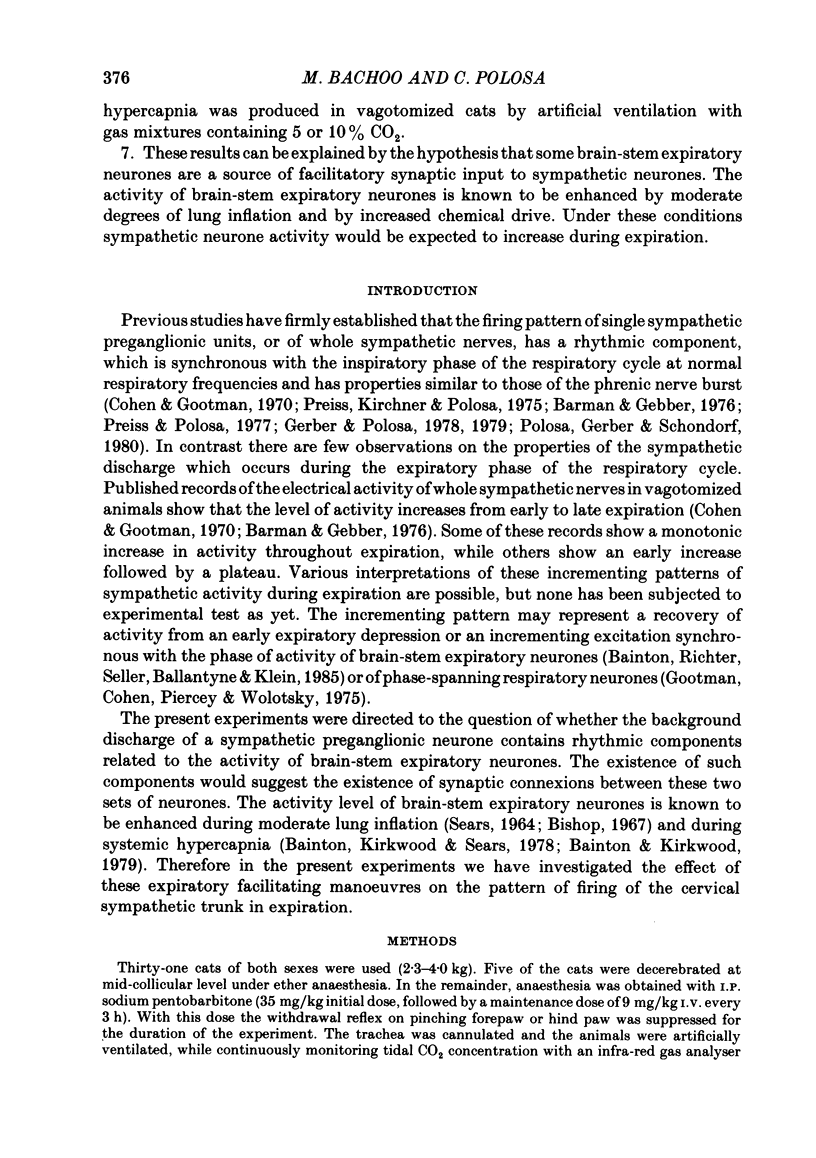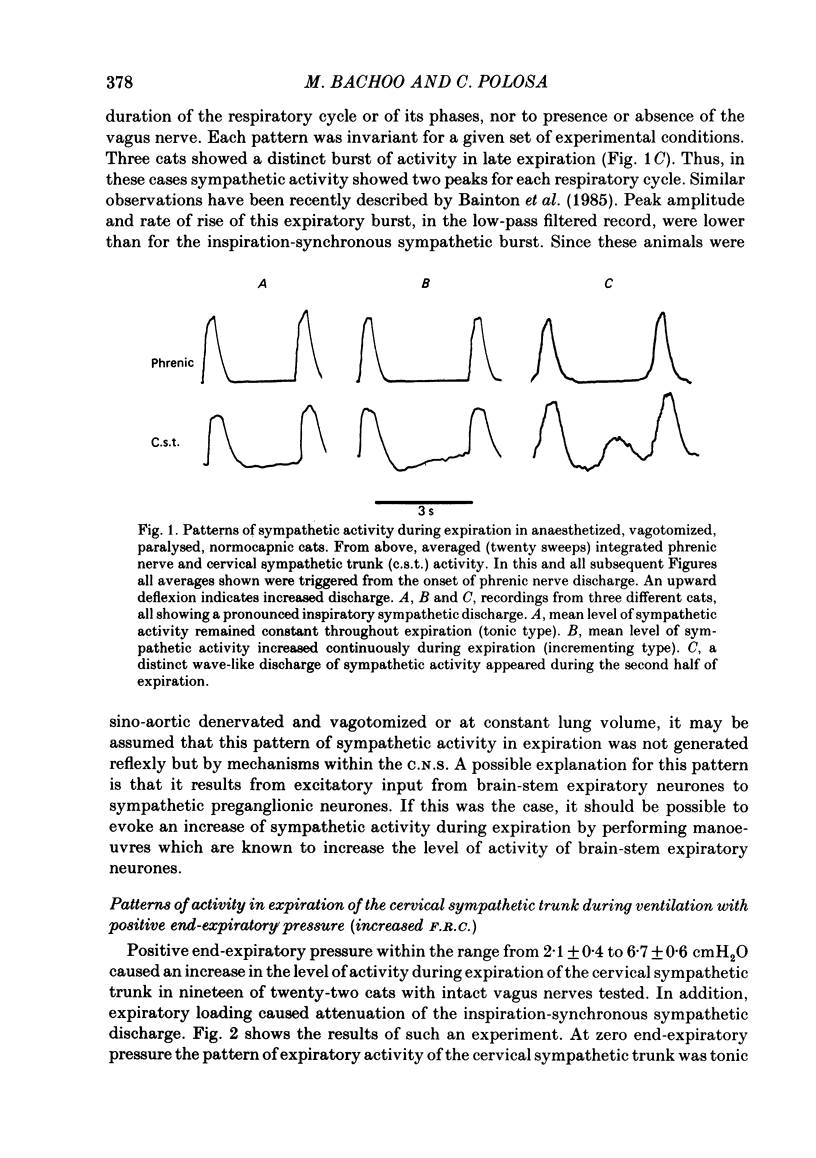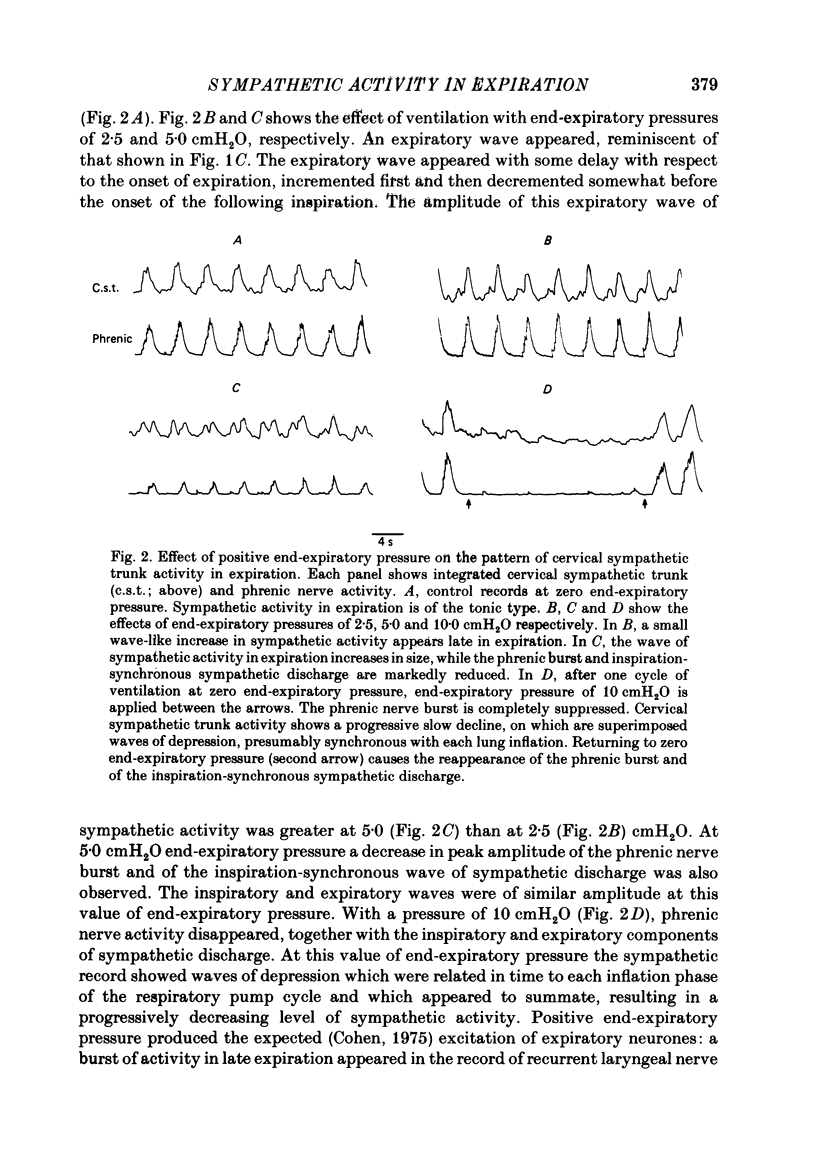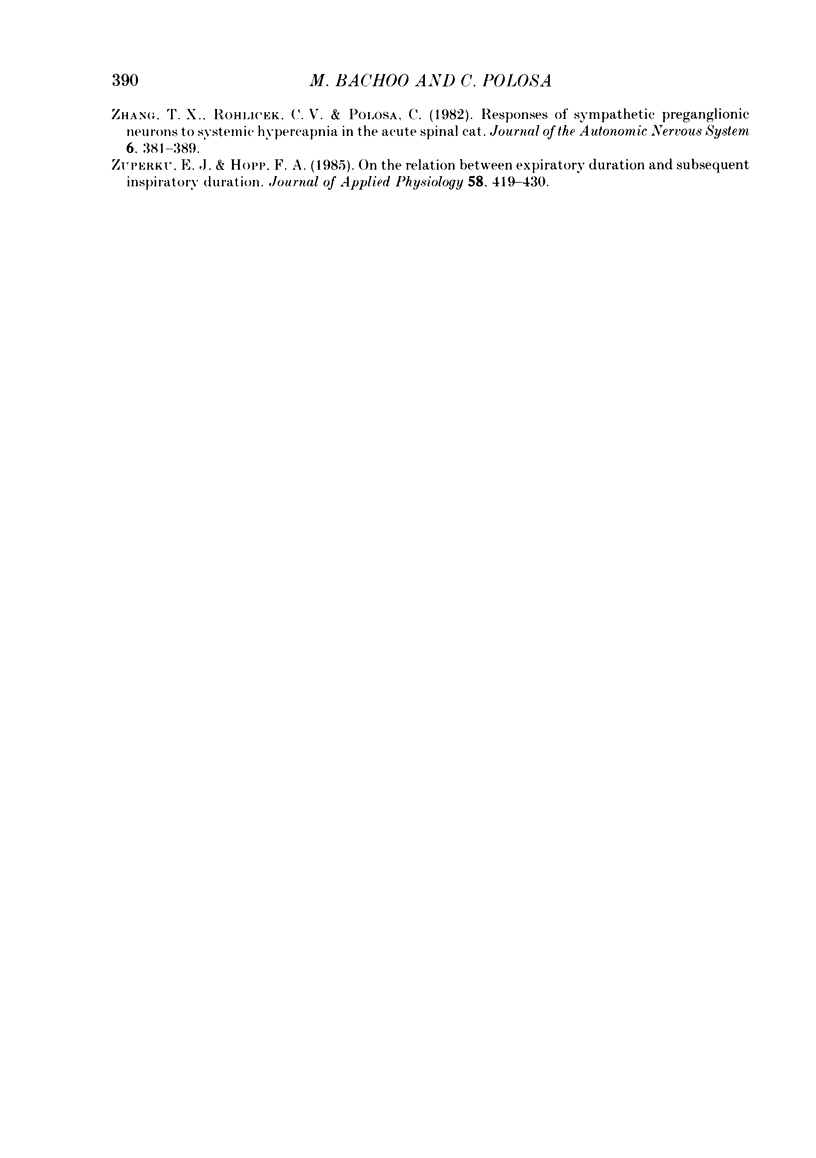Abstract
The properties of sympathetic preganglionic neurone activity during expiration were studied in pentobarbitone-anaesthetized (n = 26) and in non-anaesthetized, mid-collicular decerebrate (n = 5), paralysed, artificially ventilated cats in which the electrical activity of the phrenic nerve and of the cervical sympathetic trunk was recorded. In control conditions (end-tidal PCO2 between 35 and 40 mmHg, zero end-expiratory pressure) sympathetic activity during expiration was either steady at a low level (n = 11) or showed a modest progressive increase from a low level in early expiration (n = 17). Very infrequently (n = 3), it showed a transient increase during the second half of expiration. Artificial ventilation with positive end-expiratory pressures in the range from 2.1 +/- 0.4 (mean +/- S.D.) to 6.7 +/- 0.6 cmH2O caused, in cats with intact vagus nerves, an increase in sympathetic neurone activity during the second half of expiration. Within this range of pressures, the magnitude of the increase was related to the magnitude of the positive end-expiratory pressure. This effect reversed at higher positive end-expiratory pressures. Pressures in excess of 10.2 +/- 1.8 cmH2O caused inhibition of sympathetic activity. The sympatho-excitatory effect of positive end-expiratory pressure disappeared after bilateral cervical vagotomy. With intact vagus nerves, it also disappeared at levels of systemic hypocapnia (end-tidal PCO2 less than or equal to 15 mmHg) which abolished phrenic nerve activity. In hypocapnia, artificial ventilation with peak tracheal pressures greater than 7.2 +/- 1.1 cmH2O caused inhibition of sympathetic activity, while ventilation with lower end-expiratory pressures had no effect on sympathetic activity. It may be concluded that the sympatho-excitatory effect of positive end-expiratory pressure is mediated by vagal afferents and requires a certain level of brain-stem respiratory neurone activity. Sympatho-excitation during expiration was also observed, in normocapnic conditions, during short-duration static lung inflation with tracheal pressures in the range from 2.5 +/- 0.3 to 7.0 +/- 0.8 cmH2O as well as during artificial ventilation with zero end-expiratory pressure when lung inflation occurred in expiration. These responses were abolished by bilateral cervical vagotomy and during systemic hypocapnia. Sympatho-excitation during expiration was also observed when systemic hypercapnia was produced in vagotomized cats by artificial ventilation with gas mixtures containing 5 or 10% CO2.(ABSTRACT TRUNCATED AT 400 WORDS)
Full text
PDF















Selected References
These references are in PubMed. This may not be the complete list of references from this article.
- Arndt J. O., Pasch U., Samodelov L. F., Wiebe H. Reversible blockade of myelinated and non-myelinated cardiac afferents in cats by instillation of procaine into the pericardium. Cardiovasc Res. 1981 Feb;15(2):61–67. doi: 10.1093/cvr/15.2.61. [DOI] [PubMed] [Google Scholar]
- Bainton C. R., Kirkwood P. A., Sears T. A. On the transmission of the stimulating effects of carbon dioxide to the muscles of respiration. J Physiol. 1978 Jul;280:249–272. doi: 10.1113/jphysiol.1978.sp012383. [DOI] [PMC free article] [PubMed] [Google Scholar]
- Bainton C. R., Kirkwood P. A. The effect of carbon dioxide on the tonic and the rhythmic discharges of expiratory bulbospinal neurones. J Physiol. 1979 Nov;296:291–314. doi: 10.1113/jphysiol.1979.sp013006. [DOI] [PMC free article] [PubMed] [Google Scholar]
- Bainton C. R., Richter D. W., Seller H., Ballantyne D., Klein J. P. Respiratory modulation of sympathetic activity. J Auton Nerv Syst. 1985 Jan;12(1):77–90. doi: 10.1016/0165-1838(85)90041-4. [DOI] [PubMed] [Google Scholar]
- Baker J. P., Jr, Frazier D. T., Hanley M., Zechman F. W., Jr Behavior of expiratory neurons in response to mechanical and chemical loading. Respir Physiol. 1979 Apr;36(3):337–351. doi: 10.1016/0034-5687(79)90046-x. [DOI] [PubMed] [Google Scholar]
- Barillot J. C., Dussardier M. Activité des motoneurones laryngés expiratoires. J Physiol (Paris) 1976 Jun;72(3):311–343. [PubMed] [Google Scholar]
- Barman S. M., Gebber G. L. Basis for synchronization of sympathetic and phrenic nerve discharges. Am J Physiol. 1976 Nov;231(5 Pt 1):1601–1607. doi: 10.1152/ajplegacy.1976.231.5.1601. [DOI] [PubMed] [Google Scholar]
- Bartoli A., Bystrzycka E., Guz A., Jain S. K., Noble M. I., Trenchard D. Studies of the pulmonary vagal control of central respiratory rhythm in the absence of breathing movements. J Physiol. 1973 Apr;230(2):449–465. doi: 10.1113/jphysiol.1973.sp010197. [DOI] [PMC free article] [PubMed] [Google Scholar]
- Bianchi A. L., Barillot J. C. Activity of medullary respiratory neurones during reflexes from the lungs in cats. Respir Physiol. 1975 Dec;25(3):335–352. doi: 10.1016/0034-5687(75)90008-0. [DOI] [PubMed] [Google Scholar]
- Bishop B. Diaphragm and abdominal muscle responses to elevated airway pressures in the cat. J Appl Physiol. 1967 May;22(5):959–965. doi: 10.1152/jappl.1967.22.5.959. [DOI] [PubMed] [Google Scholar]
- Bradley G. W., Noble M. I., Trenchard D. The direct effect on pulmonary stretch receptor discharge produced by changing lung carbon dioxide concentration in dogs on cardiopulmonary bypass and its action on breathing. J Physiol. 1976 Oct;261(2):359–373. doi: 10.1113/jphysiol.1976.sp011563. [DOI] [PMC free article] [PubMed] [Google Scholar]
- Cohen M. I. Discharge patterns of brain-stem respiratory neurons during Hering-Breuer reflex evoked by lung inflation. J Neurophysiol. 1969 May;32(3):356–374. doi: 10.1152/jn.1969.32.3.356. [DOI] [PubMed] [Google Scholar]
- Cohen M. I. Discharge patterns of brain-stem respiratory neurons in relation to carbon dioxide tension. J Neurophysiol. 1968 Mar;31(2):142–165. doi: 10.1152/jn.1968.31.2.142. [DOI] [PubMed] [Google Scholar]
- Cohen M. I., Feldman J. L., Sommer D. Caudal medullary expiratory neurone and internal intercostal nerve discharges in the cat: effects of lung inflation. J Physiol. 1985 Nov;368:147–178. doi: 10.1113/jphysiol.1985.sp015851. [DOI] [PMC free article] [PubMed] [Google Scholar]
- Cohen M. I., Gootman P. M. Periodicities in efferent discharge of splanchnic nerve of the cat. Am J Physiol. 1970 Apr;218(4):1092–1101. doi: 10.1152/ajplegacy.1970.218.4.1092. [DOI] [PubMed] [Google Scholar]
- Cohen M. I. Phrenic and recurrent laryngeal discharge patterns and the Hering-Breuer reflex. Am J Physiol. 1975 May;228(5):1489–1496. doi: 10.1152/ajplegacy.1975.228.5.1489. [DOI] [PubMed] [Google Scholar]
- Coleridge H. M., Coleridge J. C., Luck J. C. Pulmonary afferent fibres of small diameter stimulated by capsaicin and by hyperinflation of the lungs. J Physiol. 1965 Jul;179(2):248–262. doi: 10.1113/jphysiol.1965.sp007660. [DOI] [PMC free article] [PubMed] [Google Scholar]
- De Burgh Daly M., Hazzledine J. L., Ungar A. The reflex effects of alterations in lung volume on systemic vascular resistance in the dog. J Physiol. 1967 Feb;188(3):331–351. doi: 10.1113/jphysiol.1967.sp008142. [DOI] [PMC free article] [PubMed] [Google Scholar]
- DiMarco A. F., DiMarco M. S., Strohl K. P., Altose M. D. Effects of expiratory threshold loading on thoracoabdominal motion in cats. Respir Physiol. 1984 Aug;57(2):247–257. doi: 10.1016/0034-5687(84)90097-5. [DOI] [PubMed] [Google Scholar]
- Farber J. P. Pulmonary receptor discharge and expiratory muscle activity. Respir Physiol. 1982 Feb;47(2):219–229. doi: 10.1016/0034-5687(82)90112-8. [DOI] [PubMed] [Google Scholar]
- Feldman J. L., Cohen M. I. Relation between expiratory duration and rostral medullary expiratory neuronal discharge. Brain Res. 1978 Feb 3;141(1):172–178. doi: 10.1016/0006-8993(78)90627-3. [DOI] [PubMed] [Google Scholar]
- Fishman N. H., Phillipson E. A., Nadel J. A. Effect of differential vagal cold blockade on breathing pattern in conscious dogs. J Appl Physiol. 1973 Jun;34(6):754–758. doi: 10.1152/jappl.1973.34.6.754. [DOI] [PubMed] [Google Scholar]
- Gerber U., Polosa C. Effects of pulmonary stretch receptor afferent stimulation on sympathetic preganglionic neuron firing. Can J Physiol Pharmacol. 1978 Apr;56(2):191–198. doi: 10.1139/y78-027. [DOI] [PubMed] [Google Scholar]
- Gerber U., Polosa C. Some effects of superior laryngeal nerve stimulation on sympathetic preganglionic neuron firing. Can J Physiol Pharmacol. 1979 Oct;57(10):1073–1081. doi: 10.1139/y79-161. [DOI] [PubMed] [Google Scholar]
- Gootman P. M., Cohen M. I., Piercey M. P., Wolotsky P. A search for medullary neurons with activity patterns similar to those in sympathetic nerves. Brain Res. 1975 Apr 11;87(2-3):395–406. doi: 10.1016/0006-8993(75)90436-9. [DOI] [PubMed] [Google Scholar]
- Green J. F., Schmidt N. D., Schultz H. D., Roberts A. M., Coleridge H. M., Coleridge J. C. Pulmonary C-fibers evoke both apnea and tachypnea of pulmonary chemoreflex. J Appl Physiol Respir Environ Exerc Physiol. 1984 Aug;57(2):562–567. doi: 10.1152/jappl.1984.57.2.562. [DOI] [PubMed] [Google Scholar]
- Grippi M. A., Pack A. I., Davies R. O., Fishman A. P. Adaptation to reflex effects of prolonged lung inflation. J Appl Physiol (1985) 1985 Apr;58(4):1360–1371. doi: 10.1152/jappl.1985.58.4.1360. [DOI] [PubMed] [Google Scholar]
- Hainsworth R. Circulatory responses from lung inflation in anesthetized dogs. Am J Physiol. 1974 Feb;226(2):247–255. doi: 10.1152/ajplegacy.1974.226.2.247. [DOI] [PubMed] [Google Scholar]
- Kunz A. L., Kawashiro T., Scheid P. Study of CO2 sensitive vagal afferents in the cat lung. Respir Physiol. 1976 Sep;27(3):347–355. doi: 10.1016/0034-5687(76)90063-3. [DOI] [PubMed] [Google Scholar]
- Petrillo G. A., Glass L., Trippenbach T. Phase locking of the respiratory rhythm in cats to a mechanical ventilator. Can J Physiol Pharmacol. 1983 Jun;61(6):599–607. doi: 10.1139/y83-092. [DOI] [PubMed] [Google Scholar]
- Preiss G., Kirchner F., Polosa C. Patterning of sympathetic preganglionic neuron firing by the central respiratory drive. Brain Res. 1975 Apr 11;87(2-3):363–374. doi: 10.1016/0006-8993(75)90434-5. [DOI] [PubMed] [Google Scholar]
- Preiss G., Polosa C. The relation between end-tidal CO2 and discharge patterns of sympathetic preganglionic neurons. Brain Res. 1977 Feb 18;122(2):255–267. doi: 10.1016/0006-8993(77)90293-1. [DOI] [PubMed] [Google Scholar]
- Remmers J. E., Gautier H. Servo respirator constructed from a positive-pressure ventilator. J Appl Physiol. 1976 Aug;41(2):252–255. doi: 10.1152/jappl.1976.41.2.252. [DOI] [PubMed] [Google Scholar]
- Russell J. A., Bishop B. Vagal afferents essential for abdominal muscle activity during lung inflation in cats. J Appl Physiol. 1976 Sep;41(3):310–315. doi: 10.1152/jappl.1976.41.3.310. [DOI] [PubMed] [Google Scholar]
- SEARS T. A. EFFERENT DISCHARGES IN ALPHA AND FUSIMOTOR FIBRES OF INTERCOSTAL NERVES OF THE CAT. J Physiol. 1964 Nov;174:295–315. doi: 10.1113/jphysiol.1964.sp007488. [DOI] [PMC free article] [PubMed] [Google Scholar]
- Sant'Ambrogio G. Information arising from the tracheobronchial tree of mammals. Physiol Rev. 1982 Apr;62(2):531–569. doi: 10.1152/physrev.1982.62.2.531. [DOI] [PubMed] [Google Scholar]
- Spells K. E. Comparative studies in lung mechanics based on a survey of literature data. Respir Physiol. 1969 Dec;8(1):37–57. doi: 10.1016/0034-5687(69)90043-7. [DOI] [PubMed] [Google Scholar]
- St John W. M. An analysis of respiratory frequency alterations in vagotomized, decerebrate cats. Respir Physiol. 1979 Feb;36(2):167–186. doi: 10.1016/0034-5687(79)90023-9. [DOI] [PubMed] [Google Scholar]
- Vibert J. F., Caille D., Segundo J. P. Respiratory oscillator entrainment by periodic vagal afferentes: an experimental test of a model. Biol Cybern. 1981;41(2):119–130. doi: 10.1007/BF00335366. [DOI] [PubMed] [Google Scholar]
- Widdicombe J. G., Sellick H. Vagal deflation and inflation reflexes mediated by lung irritant receptors. Q J Exp Physiol Cogn Med Sci. 1970 Apr;55(2):153–163. doi: 10.1113/expphysiol.1970.sp002060. [DOI] [PubMed] [Google Scholar]


